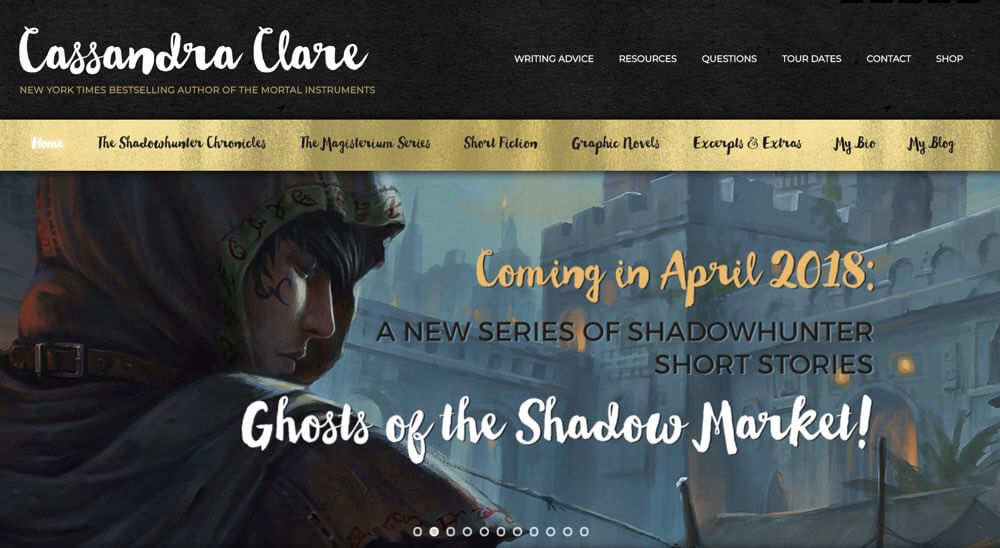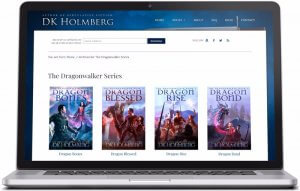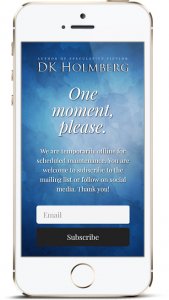Blog •
Posted on Sep 19, 2018
How I Went From Being a Blogger to Creating Author Websites
About the author
Reedsy's editorial team is a diverse group of industry experts devoted to helping authors write and publish beautiful books.
More about the Reedsy Editorial Team →Former blogger turned web designer, Joelle Reeder has worked with several New York Times bestselling authors. Since she joined the Reedsy marketplace a year ago, she has already helped countless authors build their online presence with websites that stand out. In this interview, Joelle tells us how she started her career and shares some tips on how to create the perfect author website.
Hi, Joelle. Tell us a bit about who you are and what you do.
Hi! My name is Joelle Reeder. I'm the owner of a web design and development studio based in San Diego. I'm a designer and developer, primarily for the WordPress platform. I also co-authored The IT Girl's Guide to Blogging with Moxie.
How did you get into the business of making websites? Who were your first clients?
I've been tinkering with the web since that little ‘under construction man’ gif was cool (remember him?). I'd started my own little website for my friends and myself back in the late 90s. In 2000-2001, I then started my own blog, Tenth-Muse.com, where I wrote daily in a conversational style and with a cheeky attitude that readers seemed to like. That was when blogs really started to pop up.
I spent a lot of time designing it, experimenting with the design and generally having fun and learning how blogs work. Blogging was a much smaller pond then, so when people took notice of my work, they started to ask if I'd be interested in doing it for them. For me, it was a natural transition from blogging to broader web design.
I met my friend Katherine, another talented designer, via her blog and together we hung a virtual shingle called "Blog Moxie" in February 2003. It kind of exploded, much to our surprise! So I quit my production artist job in Dallas, moved back to California while in between jobs, and started doing design full time.
In 2004, we acquired our first author client, wonderful historical fiction writer Jennifer Chiaverini — who is still our client today! By 2006, Wiley & Sons had asked if we'd like to write a book for their new tech series. After that, my business partner moved on to another profession but business kept rolling forward fast! Our firm started working with more wonderful authors like Rita McGrath, Cassandra Clare, and Sarah Rees Brennan. And now it's 2018 and I'm still doing it!

What type of clients do you usually work with today?
I work primarily with authors and artisans. I've worked with a wide variety of authors, from leaders in business to authors of afro-futurist thrillers, from YA paranormal romance to fantasy and sci-fi, from aspiring to bestselling.
I've also worked with boutique businesses for crafters and makers, such as local yarn shops (we've done lots of those!) to cheesemongers to sewing shops. I'm always open to working with most businesses or organizations, but authors and creators are my favorite!

JOIN REEDSY
Find exciting new projects
We connect publishing professionals with our community of 1,500,000 authors.
What motivates you most about the work you do?
I really love seeing people follow their dreams and create something, whether it's a book or a business. That may sound kind of cheesy, but it makes me happy to help others manifest what they want — be that through their first book, their 10th book or their small business.
I really enjoy bringing a client's personality to life online, conveying an author's unique sense of style or a shop's "interior experience" in an almost tangible way. I want readers to recognize their author's genre or feel like they are in their local yarn shop when visiting their website. I’ve also learned that a website doesn't have to be visually dry to be adaptive on mobile devices, and I love showing my clients that we can do more with their brand.
Tell us about an interesting project you worked on via Reedsy.
I've really been lucky to work with so many great authors here on Reedsy. I've got a few projects in the mix right now, but a recent Reedsy client has been DK Holmberg, a prolific fantasy author, among other genres. He has been wonderful to work with and I had a lot of creative freedom to design something for him that reflected his style, but still allowed for growth in other genres.

We ended up creating a custom interface for him to add books and organize them by "world" and "series" (in which a "world" could contain multiple series), and we made it really simple for him to add new books as he writes them. I also set up foundational search engine optimization and unique book page layouts to entice search engine indexing as well as reader book purchase.
How do you typically approach a new project, from initial brief to deliverable results?
When you contact me, I will usually respond with a greeting and ask a bit more about your project that may not be in your brief, especially your preferred budget and launch date — all before offering a quote.
Each project is unique, so there is no set process from this point. Sometimes, clients are focusing on a book deadline and don’t have personal bandwidth for a lot of back and forth. In the case of DK’s, for example, he showed me his existing website, told me what colors and “vibe” he wanted, and then gave me creative carte blanche.
Other times, especially when I create a website from scratch, there is a more step-by-step process. I create some mockups of each page that I review with the client before moving to the design and development phase.
Q: What specific skills do you need to design author websites?
Suggested answer
You need web design skills! These days, you don't need to know how to build a web page in HTML, but you do need to know the basics of how web pages and browsers function together to display a web page. Here are some basics to cover:
- Basic Server and Domain Knowledge. Learn how to manage the hosting and domain name, and the difference between the two. I don't know how to build or manage a server itself, but I know how the ins and outs of my host and domain registrar.
- Basic HTML/CSS tags. Even with drag-and-drop builders, you need to know what is going on under the surface. You'll almost always need to inject some custom CSS or a basic script somewhere along the way.
- Basic SEO. Understand how to properly use heading tags, meta descriptions and image alt tags, at the bare minimum.
- Colors. Get good enough at creating color schemes. There are plenty of tools online that can help with this. I use Paletton.
- Information Architecture. This includes building the sitemap (which pages go where) and on-page content (what content goes where on the page.)
- Integrating email marketing platforms. Almost every author I've built a site for wants a subscribe form. Learn how to embed these forms.
That's a basic list to get you started!
Chad is available to hire on Reedsy ⏺
Designing an author website isn’t just about looking pretty. It’s about giving readers a place that feels like your book.
The key skills you need?
- Storytelling → turning your voice into a digital experience.
- Branding → using fonts, colors, and images that feel like you.
- Clarity → making it easy for readers to find what matters (your books, your bio, your contact).
- Editing → cutting the clutter so your story shines.
- Flow → guiding readers naturally toward joining your list or buying your book.
When all of this comes together, your site stops being a résumé… and becomes an invitation.
Your website is your first page. Make it worth turning.
Maite dalila is available to hire on Reedsy ⏺
Building websites for authors isn’t quite the same as designing for other businesses. You’re not just creating a digital brochure or a sales funnel. You’re building a space that reflects someone’s personality, showcases their work, and helps readers connect with them.
It’s a mix of creative, technical, and practical skills. Here’s what you really need if you want to do it well.
1. A good eye for design
This probably goes without saying, but the site needs to look good. Fonts, colours, spacing, layout—it all needs to feel considered. A messy or outdated site gives the wrong impression, even if the writing is great. You don’t need to be a trained graphic designer, but you do need to understand how to make things look clean, balanced, and easy to read.
2. An understanding of how people use websites
It’s not just about how it looks. It’s also about how it works. Can a reader quickly find the latest book? Is there a simple way to join the mailing list? Are the key links easy to tap on a phone? Knowing how visitors actually move through a site is key, especially when you’re designing for readers who may not be particularly techy.
3. Clear, concise content
Authors are good at writing, obviously. But writing for a website is different. You need to help shape the content so it gets to the point quickly and encourages people to take action. That might mean rewriting a rambling bio, tightening up a homepage introduction, or suggesting a stronger headline. It’s not about replacing the author’s voice—it’s about making sure that voice works online.
4. Basic SEO knowledge
A big part of an author’s audience will find them through Google, so the site needs to be easy to discover. That means knowing how to use keywords sensibly, writing image descriptions, setting page titles, and getting the overall structure right. You don’t need to be an SEO expert, but you do need to understand the foundations.
5. Confidence with the platform
Whether you're using Wix, WordPress or something else, you need to be comfortable with the tools. That includes building forms, connecting domains, setting up mailing list integrations, and making sure it all works properly on mobile. A lot of time can be wasted fumbling around with settings if you’re not familiar with how things work behind the scenes.
6. The ability to listen
Not every author wants the same thing. Some want to build a list, some want to impress a publisher, others just want a clean place to showcase their books. Listening carefully at the start, asking good questions, and understanding what the author actually needs is one of the most useful skills you can have.
Stuart is available to hire on Reedsy ⏺
When a project is over, I usually include some time in the agreement for post-launch support — I'm not going to launch and disappear. Once the agreement is complete, I assure my client that they can contact me any time for future work, questions, or anything else they might need for their website or digital presence — I can always help.
What tips would you give to authors looking to create a great website?
1. First, figure out what you can achieve with your budget and timeline.
There are plenty of great solutions for websites within all budgets. Don't be afraid to tell your designer/developer your budget! We’re not here to max it out; we are here to help you get the most impact and value out of your website investment.
Yes, some sites cost more than others, but I’m not going to pitch you a penthouse when your budget is more in the "2 bedroom fixer-upper" range. I want to help you succeed within your comfort zone.
2. Inquire early with designers and developers.
This is especially crucial if you’re on a deadline or have a small budget, as they can often help you define what you need (and weed out things that you don't), or point you in the right direction until you're ready for them.
3. Buy your domain name as soon as you want it — don't wait or it may be gone!
Occasionally clients will tell me an amazing domain name and website idea, only to be disappointed when I tell them it’s already taken. If you have an idea for a good URL, first look it up to see if anyone else has it and if they don’t, buy it.
4. Finally, make sure your website is responsive (aka adaptive or mobile-ready).
This means the design we create for your site needs to look great on your laptop and then adapt or respond to the device you’re viewing it on to change the look accordingly. This is not a separate “mobile site design”, this is one site design adapting to the device it’s being viewed on.

Since mobile devices count for 57% or more of the internet’s traffic, earlier this year Google started indexing for mobile-responsive sites, potentially with a higher ranking. It’s imperative that your site be Google-friendly (and friendly for other search engines), as well as visually pleasing.
That said, not only would your content adapt and display differently based on device, you could, if you were so inclined, have your site be purple on a desktop but change it to yellow on a smartphone. On tablets, maybe your site is blue. This is a basic example, but it can provide a lot of options creatively, as well as practically.
From a human and end-user standpoint, my most successful websites are those where the author or owner engages with their readers. Make your copy welcoming, let your readers feel you're speaking right to them. Avoid overly gimmicky or lengthy copy.
Whether you write regularly on your blog, import your tweets or Facebook posts, or even just share your Instagram photos... remember to give your readers a piece of you. They’re on your website to learn more about you, after all. And you are there to get them to buy your books... so strategic calls-to-action that don’t come off as spammy are essential, too.
Essentially, you want your website to guide and engage your readers, just like you do with your books.

FREE RESOURCE
The Full-Time Freelancer's Checklist
Get our guide to financial and logistical planning. Then, claim your independence.
Looking for more tips and guides for freelance publishing professionals? Head to the Reedsy Freelancer Blog.
Reviewed by Linnea Gradin
The editor-in-chief of the Reedsy Freelancer blog, Linnea is a writer and marketer with a degree from the University of Cambridge. Her focus is to provide aspiring editors and book designers with the resources to further their careers.
As the editor of Reedsy’s freelancer blog and a writer on the Reedsy team, Linnea has her hand in a bit of everything, from writing about writing, publishing, and self-publishing, to curating expert content for freelancing professionals. Working together with some of the top talent in the industry, she organizes insightful webinars, and develops resources to make publishing more accessible to writers and (aspiring) publishing professionals alike. When she’s not reading, she can be found dribbling on the football pitch, dabbling in foreign languages, or exploring the local cuisine of whatever country she happens to be in at the time.

